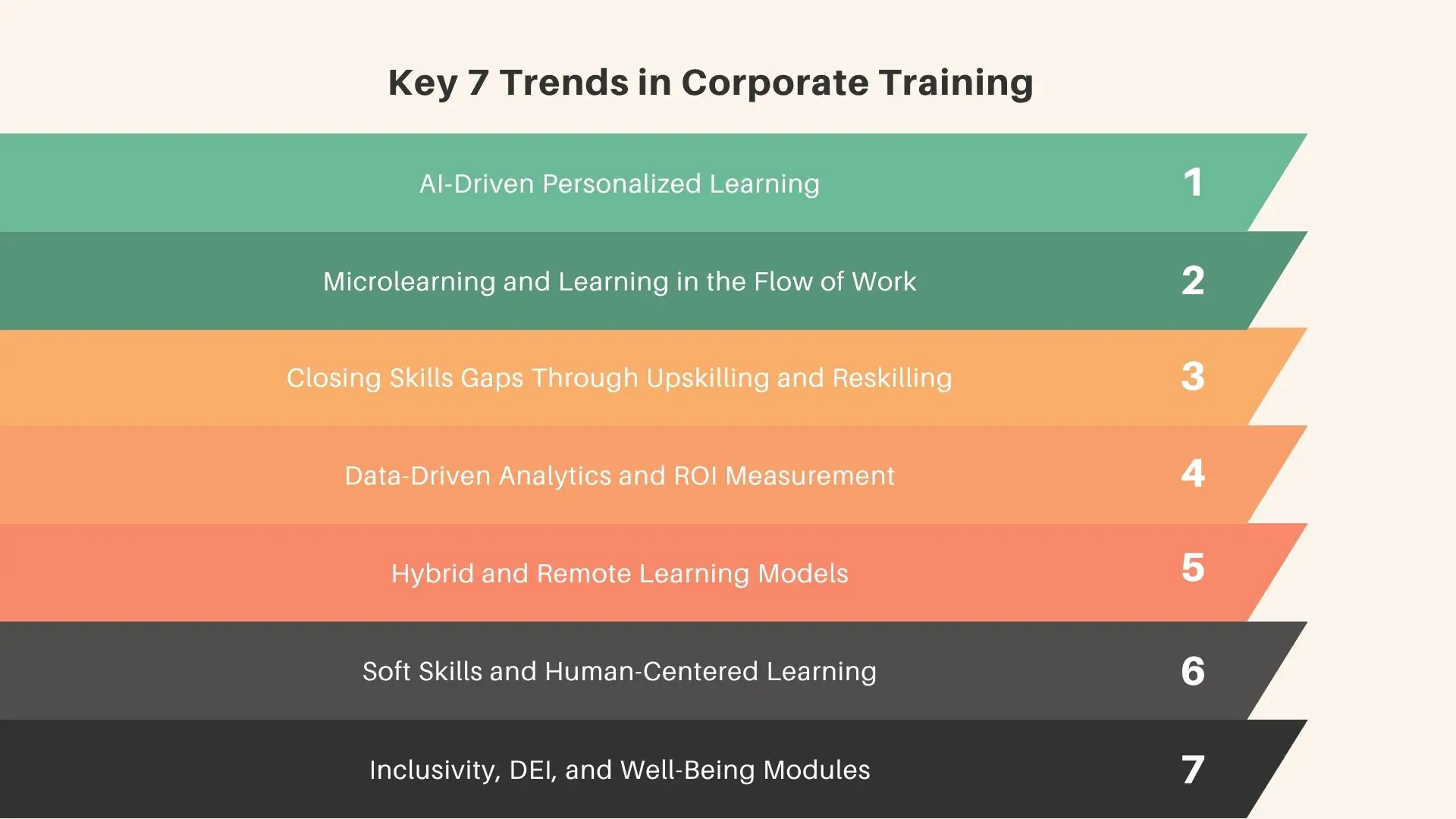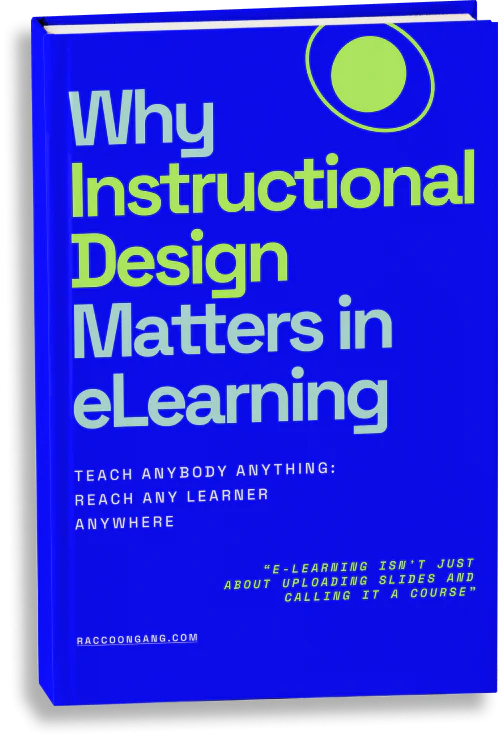Trends in corporate training are not just about staying current. They signal how well a company is preparing for the future. Ignoring them puts employee growth, team performance, and long-term success at risk.
2025 will not be a repeat of 2023 or 2024. The shift to digital is the baseline. But what’s emerging now is more nuanced. It’s about how companies adapt learning to new expectations, leadership gaps, and business uncertainty.
Workforce upskilling has moved from being HR’s concern to becoming a boardroom issue. Leadership development is no longer about filling roles — it’s about building flexible minds. And employee development is judged by more than course completions. Learners want relevance, autonomy, and visible value.
At Raccoon Gang, we’ve been building corporate learning solutions for over 10 years. We’ve prepared this article to show you the most important trends in corporate learning for 2025 (i.e., the trends of tomorrow, essentially). But we also want to highlight the long-term changes that companies and organizations will face in terms of employee training and development.
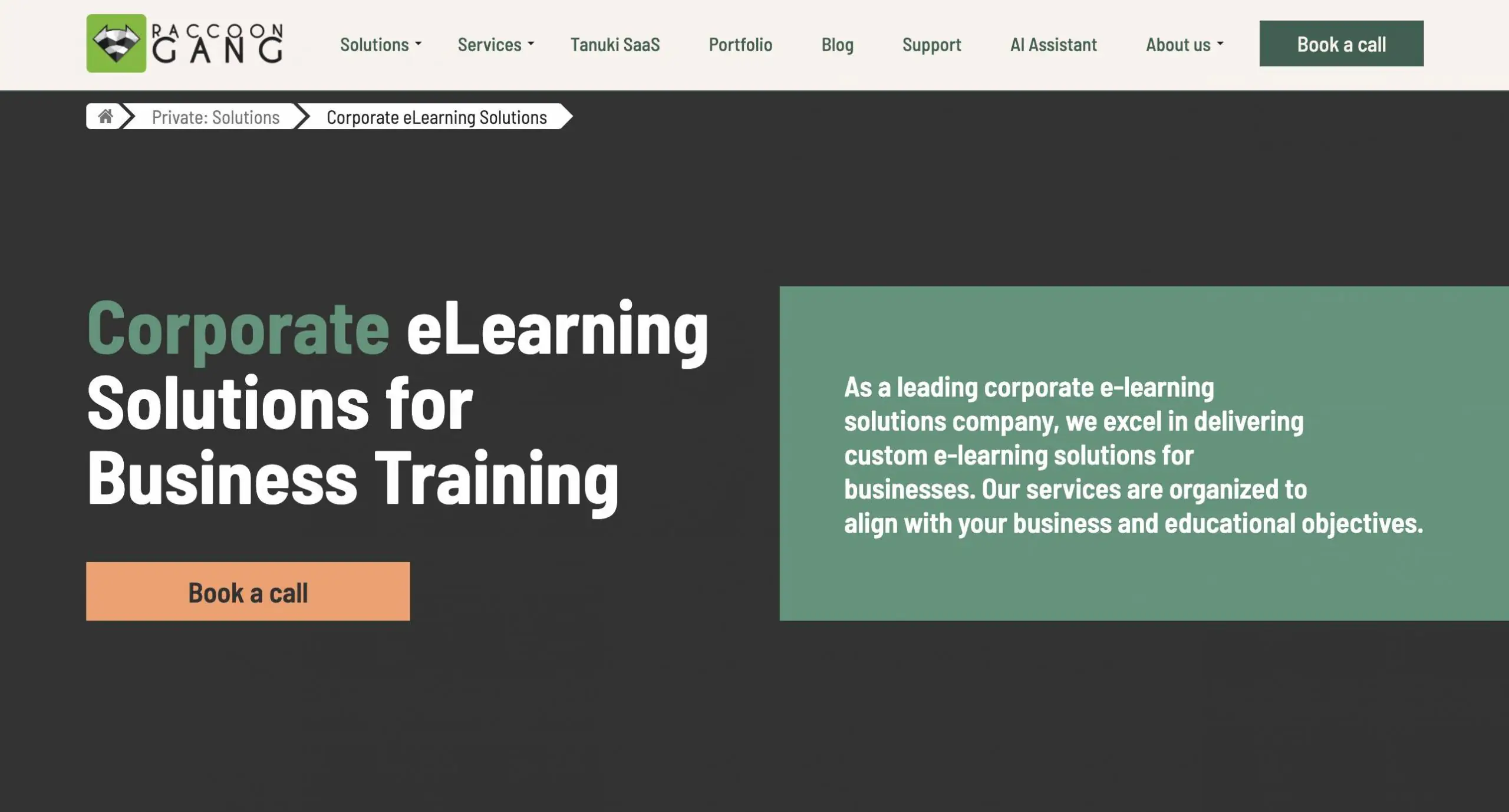
Raccoon Gang’s Corporate eLearning Solutions Page. The company offers custom Open edX-based training systems tailored to business goals, supporting scalable and measurable employee development.
Why Companies Must Follow Corporate Training Trends
Most companies track business trends or market shifts. But corporate training trends often get overlooked until there’s a crisis. Imagine this: you stop investing in employee training and development. What happens after a year? Teams start repeating mistakes. New tools go unused. Managers spend more time fixing problems than moving forward.
Now, picture five years without training. Your best people leave. Processes break down. Innovation stalls. The business starts to lose ground not because of the market, but because your people have stopped growing.
“Employees want training that prepares them for what’s next, not just their current role. Yes, that future will not always be related to your company. But when people feel you’ve invested in their growth, they tend to stick around. According to LinkedIn Learning, 94% of employees say they would stay longer at a company that supports their learning and development.” — HR Lead at Raccoon Gang.
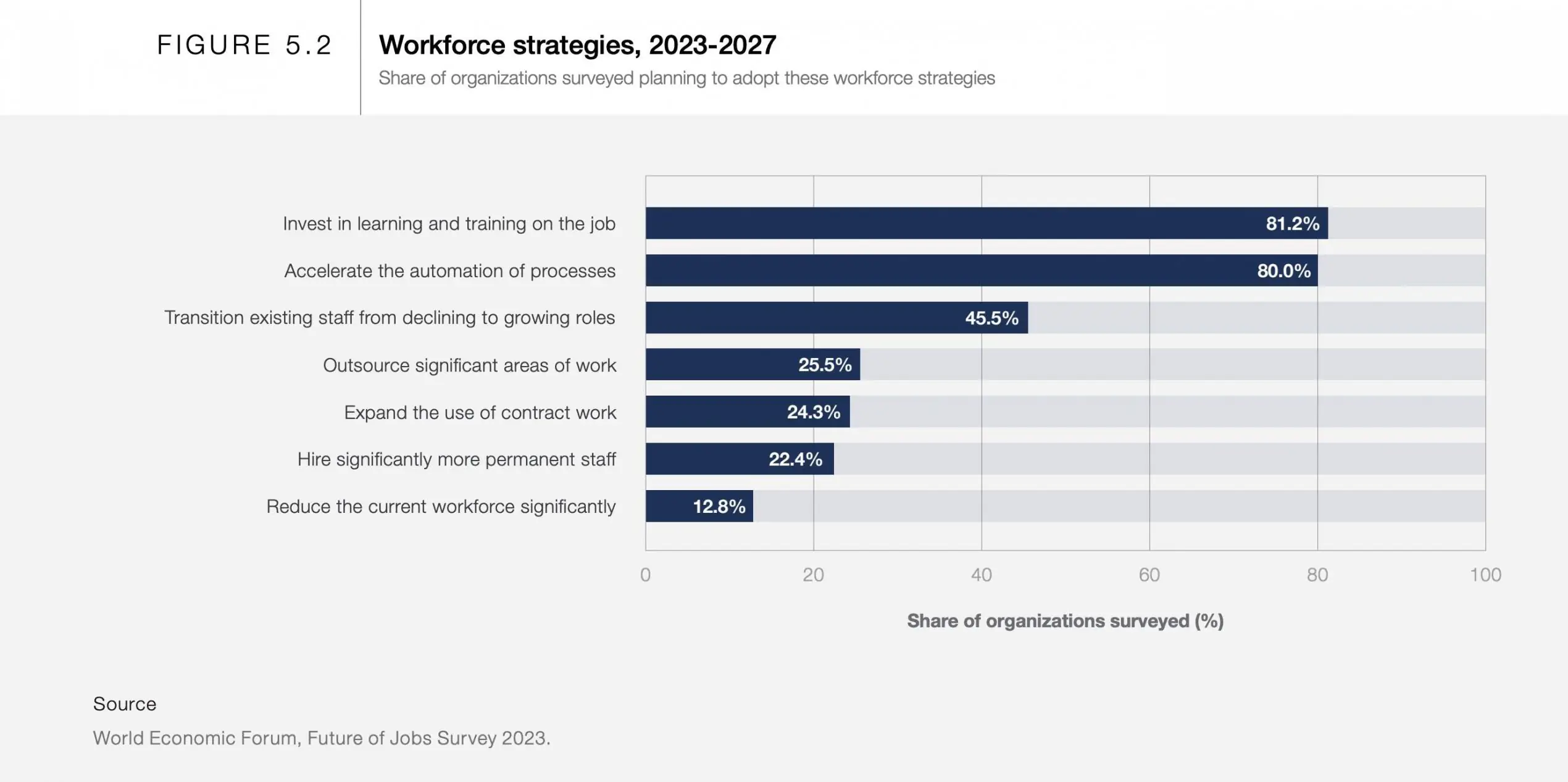
Figure: Workforce Strategy Priorities for 2023–2027. According to the World Economic Forum, 81.2% of companies plan to invest in learning and on-the-job training — making it the top strategy for navigating future workforce shifts.
Training Is Now a Strategic Business Tool
In reality, your training strategy reflects your company’s ability to move and adapt. Fall behind on learning, and you fall behind on everything else.
Corporate learning strategy used to be reactive. A new tool rolls out, so teams get trained. But that’s no longer enough. The speed of change in digital tools, customer needs, and leadership demands now requires a proactive approach.
Remember, employees expect growth, not just onboarding. They compare your training to what they see inside and outside the industry.
Here’s what’s changing:
- Training is becoming part of your company strategy, not a side project.
- Upskilling is now a retention tool, not just a skills gap fix.
- Leadership development programs are moving beyond checklists to focus on future-readiness.
Ignoring these changes creates risk. By tracking corporate training needs now, your L&D teams can build systems that grow with the business. And that’s where the real advantage lies. Let’s discover the top 7 trends in corporate training.
Key 7 Trends in Corporate Training for 2025
Trends in corporate training development are shifting from course-centered delivery to learner-centered ecosystems. The goal is no longer to train more, but to train smarter — with impact, relevance, and measurable results. Below are the seven employee training and development trends you need to watch.
AI‑Driven Personalized Learning
Let’s be honest, AI was a trend two years ago. Today, its prevalence has gone beyond the buzzword level and is more of a necessity. AI tools help L&D teams create learning content, adapting it in real time to learner behavior. With tools like the AI Assistant from Raccoon Gang, you can automate the creation of new learning materials, provide feedback, and conduct assessments. As you plan next year’s roadmap, add a sober review of AI in learning and development pros and cons so you don’t chase every shiny tool.
58% of L&D professionals say AI-powered personalization is the trend most likely to impact corporate learning this year.
Microlearning and Learning in the Flow of Work
Today, people are watching YouTube at a speed of at least x1.5. We all have to be in a hurry. Our pace of life has accelerated so much that it is reflected in the way we learn. Today, a two-hour training material will interest almost no one, and moreover, people will definitely not remember anything, even if a miracle happens and they watch it to the end.
Microlearning for employees is not a new trend, but embedding it into day-to-day work is the real breakthrough. Bite-sized modules improve training effectiveness and keep learning close to actual tasks.
For example, you can discover how Mobile Learning Apps now deliver microlearning and updates within workflows. This is not a trend driven by novelty — it’s about staying relevant when attention is limited.
Closing Skills Gaps Through Upskilling and Reskilling
The World Economic Forum estimates that 60% of workers will need training by 2027. That’s not a long runway. Many CEOs believe their business viability depends on how quickly they close the skill gap.
Upskilling is about future-proofing employees. Reskilling is about rethinking roles and responsibilities. Both are now top priorities for L&D and HR teams working together.
The fastest-growing capabilities include analytical thinking, adaptability, and emotional intelligence — a clear sign that both tech and people skills matter.
Data-Driven Analytics and ROI Measurement
Companies want to see proof that learning is worth the investment. That’s why training ROI will become a central metric for L&D teams. Dashboards now track how learning impacts performance, retention, compliance, and sales.
With improved LMS analytics and reporting tools, the connection between learning and business goals is no longer guesswork. It’s a trend.
This change also helps L&D teams secure more budget by demonstrating value with data, not just tales.
Hybrid and Remote Learning Models
Training is no longer tied to the office. As hybrid work becomes the norm, learning delivery must follow suit. The new standard combines live sessions, asynchronous courses, and mobile access — all in one system.
E-learning for business needs to support flexibility while ensuring consistency. Platforms that centralize resources and provide access across devices will lead the way in remote learning.
The challenge now is not offering digital training. It’s offering the right format at the right time.
Soft Skills and Human-Centered Learning
While AI grows, human soft skills remain what sets us apart from machines. Ask yourself, is there a difference between communicating with an AI assistant or a live operator, even when it comes to banking services or booking tickets? And we are not even talking about non-violent communication, inclusiveness, etc.
When we talk about corporate life, soft skills like communication, empathy, and conflict resolution become the foundation on which the satisfaction of each team member and the team is based.
To develop soft skills, companies should implement approaches such as mentoring programs, peer coaching, and experiential learning. The trend is to create personalized learning paths. Depending on the position and skill set, each team member can rely on their own learning path.
Let’s look at the forecast from Deloitte: by 2030, two-thirds of jobs will rely on soft skills. What does it mean for businesses? Ignoring them today could cost companies tomorrow.
Inclusivity, DEI, and Well-Being Modules
As corporate life becomes more flexible, teams become more diverse. This diversity should be reflected in training programs.
The next trend in this direction will be to reflect diverse voices and support mental health. DEI training, which stands for Diversity, Equity, and Inclusion, now includes immersive tools to build empathy and test for cultural sensitivity.
Well-being modules will occupy an essential place alongside compliance training. Topics like burnout, stress management, and healthy work habits should be added to leadership training and onboarding.
On the one hand, we were surprised, and on the other, it was a pleasant surprise to discover that research confirmed that organizations with greater gender and ethnic diversity have a corresponding 25% and 36% likelihood, respectively, of financially outperforming their peers. In addition, “diverse companies earn 2.5x higher cash flow per employee,” “inclusive teams are over 35% more productive,” and “diverse teams make better decisions 87% of the time.” — Elearning Development Lead at Raccoon Gang.
The result of this trend is a shift toward employee training and development trends that respect the full human experience, not just job performance. This will require the proper functionality from online training platforms (full accessibility is a minimum).
How Raccoon Gang Helps Companies Stay Ahead
Keeping up with corporate training development trends means more than reacting to change. It requires building systems that adapt, scale, and support real business goals. At Raccoon Gang, we help companies do just that by using Open edX for corporate learning and offering expert services grounded in modern instructional design.
What You Get with Raccoon Gang
We have developed online employee training software that directly supports trends like AI-driven personalization, microlearning, training ROI measurement, and soft-skills development.
- Analytics Tool: Monitor progress, spot bottlenecks, and improve training effectiveness across departments.
- Gamification Tool: Boost learner engagement by 60% with game mechanics and performance-based rewards.
- Mobile App: Deliver learning in the flow of work. Your employees train when and where it suits them.
- Instructional Design: Our team will create engaging courses for your team.
These digital learning tools support content delivery and help companies to build flexible, measurable, and inclusive training programs.
Success Stories: Corporate Training Solutions By Raccoon Gang
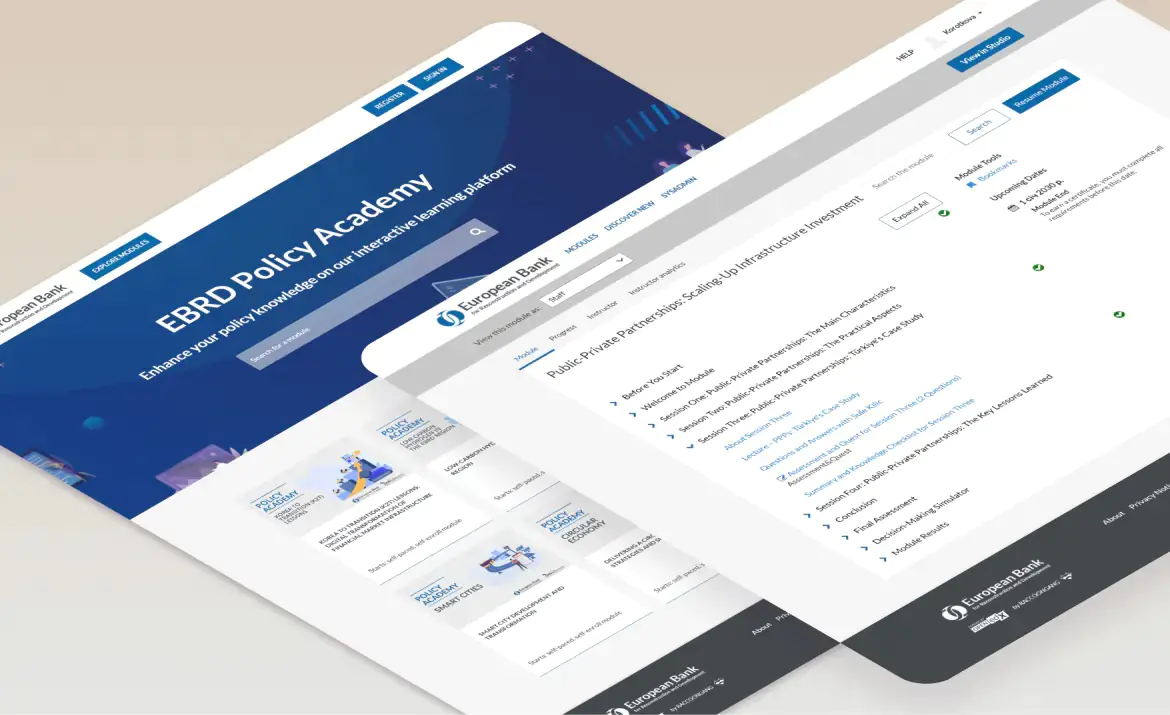
Custom training platform developed for EBRD. The project was designed to expand learner capacity by enabling scalable skill and knowledge transfer across regions.
EBRD: Making Knowledge Transfer Scalable
We helped the European Bank for Reconstruction and Development (EBRD) build custom e-learning content that supports multilingual delivery and accessibility. The solution included localized materials, interactive slides, and tailored video content. This initiative aligned directly with EBRD’s goal of workforce upskilling across diverse regions.

NASA’s Open Science 101 modules on a Branded Open edX platform. The solution delivers a seamless, fully branded learning experience to support consistent onboarding and scientific training.
NASA: Enabling Open Science Through Digital Learning
For NASA’s Open Science 101, we developed a modular curriculum focused on onboarding scientists to new research practices. The project emphasized instructional clarity, soft-skill application, and self-paced learning through an Open edX platform — all core components of future-ready training.
Benefits of Staying Trend-Aware
Following corporate training development trends presently supports long-term business performance and employee retention. Here’s what companies gain when they stay ahead:
Improved engagement
Relevant, personalized training keeps employees motivated and active in their development.
Measurable ROI
Trend-aligned programs use analytics to show clear links between learning and performance.
Better leadership training
Soft skills, empathy, and adaptability are built into modern programs that prepare managers for complex challenges.
Future-ready workforce
Training evolves with changing roles and tech. Staying updated helps reduce skill gaps before they affect results.
And the pressure is real: 44% of workers’ skills will be disrupted within five years, and 6 in 10 workers will need additional training by 2027, according to WEF research.
Conclusion
The trends we’ve covered in this article are signals, not suggestions. Thank you for reading our article 😉
But on a more serious note, there’s one clear takeaway: training is a core driver of growth, retention, and innovation in the near future. Such trends of corporate learning as AI, microlearning, skill-based development, and inclusive models are already reshaping what effective training looks like.
Many companies will delay. They’ll tweak what they have and hope it holds. But hope isn’t a strategy.
If you haven’t reviewed your training programs recently, now’s the time. Are your tools flexible? Are you tracking impact? Do your courses meet the needs of a modern workforce?

